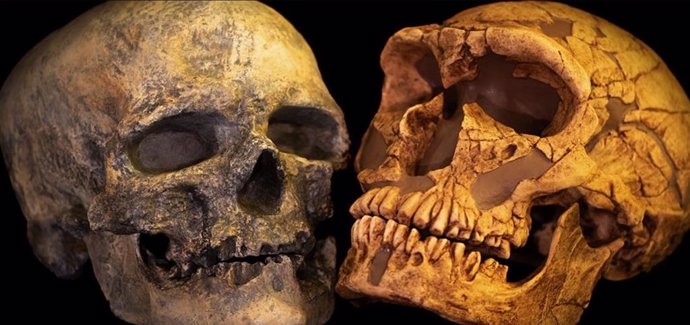Archive – Modern human and Neanderthal skull – CLAUDIO QUILODRÁN – Archive
12 Jul. () –
The first human groups had a history of genetic intermingling and exchange that suggests a much more intimate connection among these of what has been established until now.
It is the discovery of an international team of geneticists and artificial intelligence experts, led by Joshua Akey, a professor at Princeton’s Lewis-Sigler Institute for Integrative Genomics.
“This is the first time that geneticists have identified multiple waves of modern human and Neanderthal admixture.“said Liming Li, a professor in the Department of Medical Genetics and Developmental Biology at Southeast University in Nanjing, China, who conducted this work as a research associate in Akey’s lab.
“We now know that for the vast majority of human history, we’ve had a history of contact between modern humans and Neanderthals,” Akey said. The hominins who are our most direct ancestors split off from the Neanderthal family tree about 600,000 years ago, and then developed our modern physical features about 250,000 years ago.
“From then until the Neanderthals disappeared, that is, for about 200,000 years, modern humans have been interacting with Neanderthal populations,” he said.
The results of their work appear in the Science magazine.
Neanderthals, once thought of as slow and dumb, are now seen as skilled hunters and toolmakers who healed their wounds with sophisticated techniques and were well adapted to thrive in Europe’s cold climate.
All of these hominin groups are humans, but to avoid saying “Neanderthal humans,” “Denisovan humans,” and “ancient versions of our own species of humans,” most archaeologists and anthropologists use the abbreviations Neanderthals, Denisovans, and modern humans.
Using genomes from 2,000 living humans, as well as three Neanderthals and one Denisovan, Akey and his team They mapped gene flow between hominin groups over the last quarter million years.
The researchers used a genetic tool they designed a few years ago called IBDmix, which uses machine learning techniques to decode the genome. Previous researchers relied on comparing human genomes to a “reference population” of modern humans thought to have little or no Neanderthal or Denisovan DNA.
Akey’s team has established that even these reference groups, living thousands of kilometres south of the Neanderthal caves, They have traces of Neanderthal DNA, probably carried south by travelers (or their descendants).
Using IBDmix, Akey’s team identified a first wave of contact about 200-250,000 years ago, another wave 100-120,000 years ago, and the largest one about 50-60,000 years ago.
That contrasts sharply with previous genetic data. “To date, most genetic data suggests that modern humans evolved in Africa 250,000 years ago, stayed there for the next 200,000 years.” and then decided to disperse out of Africa 50,000 years ago and continued to populate the rest of the world“Akey said.
“Our models show that there wasn’t a long period of stagnation, but rather soon after modern humans appeared, we’ve been migrating out of Africa and back into Africa as well,” he said. “To me, this story is about dispersal, that modern humans have been moving around and encountering Neanderthals and Denisovans much more than we previously recognized.”
This vision of humanity in motion coincides with archaeological and paleoanthropological research that suggests a cultural and tool exchange between hominid groups.
Li and Akey’s key insight was to look for modern human DNA in Neanderthal genomes, rather than the other way around. “The vast majority of genetic work over the past decade has really focused on how mating with Neanderthals affected modern human phenotypes and our evolutionary history,” But these questions are also relevant and interesting in the reverse case.”Akey said.
They realized that the offspring of those early waves of mating between Neanderthals and moderns must have remained with the Neanderthals, leaving no record in living humans. “As we can now incorporate the Neanderthal component into our genetic studies, We are seeing these earlier dispersions in ways we couldn’t before.“Akey said.
The final piece of the puzzle was the discovery that the Neanderthal population was even smaller than previously believed.
Genetic models have traditionally used variation (diversity) as a proxy for population size. The more diverse the genes, the larger the population. But using IBDmix, Akey’s team showed that a significant amount of that apparent diversity came from DNA sequences that had been found in the genomes of Neanderthals.
















Add Comment